Key takeaways:
- Creating a vibrant atmosphere and fostering connections through networking can significantly enhance event experiences.
- Effective preparation, including a checklist and mental visualization, helps alleviate stress and ensure a productive engagement.
- Utilizing engaging strategies such as icebreakers and storytelling promotes genuine interactions among attendees.
- Reflecting post-event aids in personal growth by identifying areas for improvement and appreciating valuable connections.
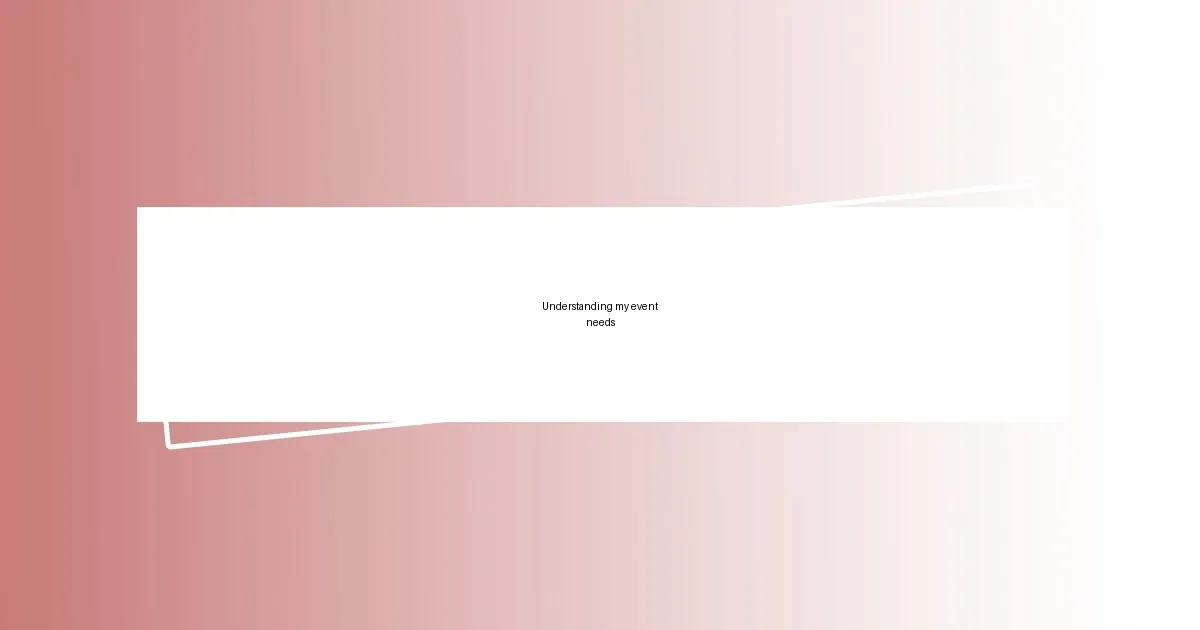
Understanding my event needs
When I think about my event needs, I often reflect on what truly makes an experience memorable for me. I’ve discovered that it’s not just about the logistics; it’s the atmosphere that matters. Have you ever walked into a room and instantly felt a sense of energy or excitement? For me, that buzz is crucial.
I also realize that I thrive on connections during events. There was a conference I attended where I met a few incredibly inspiring individuals, and those conversations made the event worthwhile. I can’t help but wonder: how often do we overlook the importance of networking in our pursuit of learning? Every interaction can spark new ideas and motivate us in unexpected ways.
Additionally, clarity is vital to my event experience. Once, at a workshop, I remember feeling overwhelmed by unclear instructions. It made me question my understanding of the topic. How can we fully engage if we’re consistently trying to decipher what’s expected of us? Ensuring clear communication from the outset allows me to immerse myself fully in the experience and derive actual value from it.
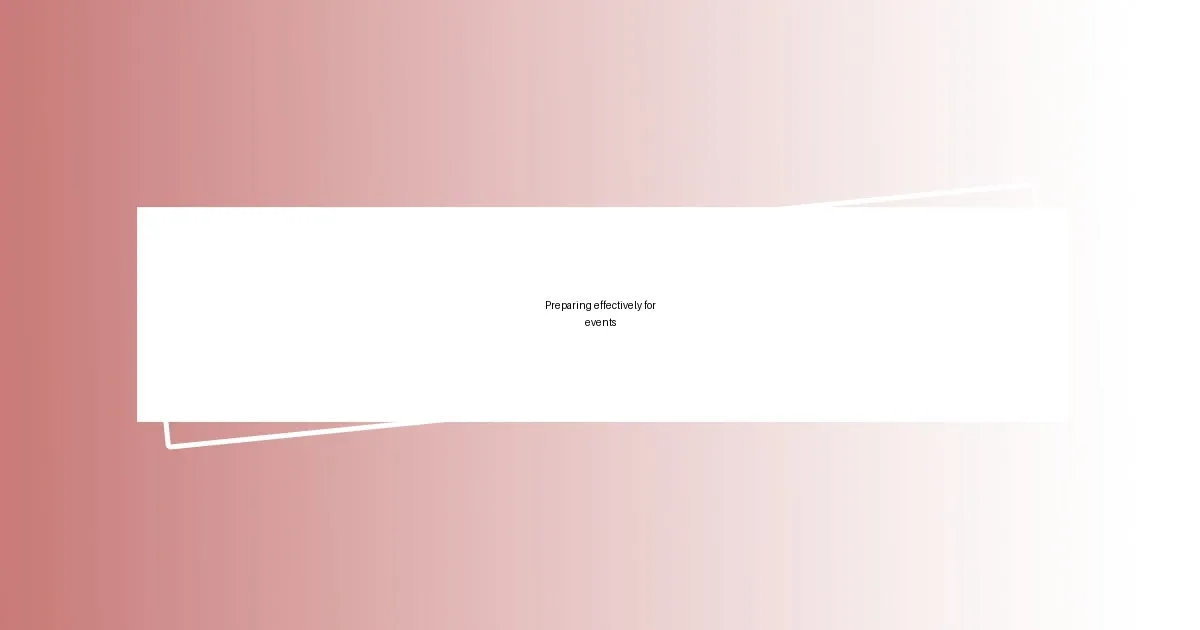
Preparing effectively for events
When it comes to preparing effectively for events, I’ve learned that a well-thought-out checklist can be my best friend. I remember the time I showed up at a workshop without my notebook—such a rookie mistake! It left me frustrated, struggling to capture the key insights. Now, I make sure everything I might need is ready to go the night before. This simple ritual sets a positive tone for the day, allowing me to focus on what truly matters: the experience itself.
Here’s a quick list of what I always prepare before heading to any event:
- Research the event agenda and identify sessions that align with my interests.
- Pack essentials: notebook, pens, business cards, and any specific materials needed.
- Dress for comfort yet maintain a professional appearance—first impressions count!
- Plan my arrival time to avoid stress and ensure I can network effectively.
- Review personal goals: What do I hope to gain from this event?
Each of these steps provides a little armor against the unpredictability of gathering spaces and helps me stay grounded and ready to connect.
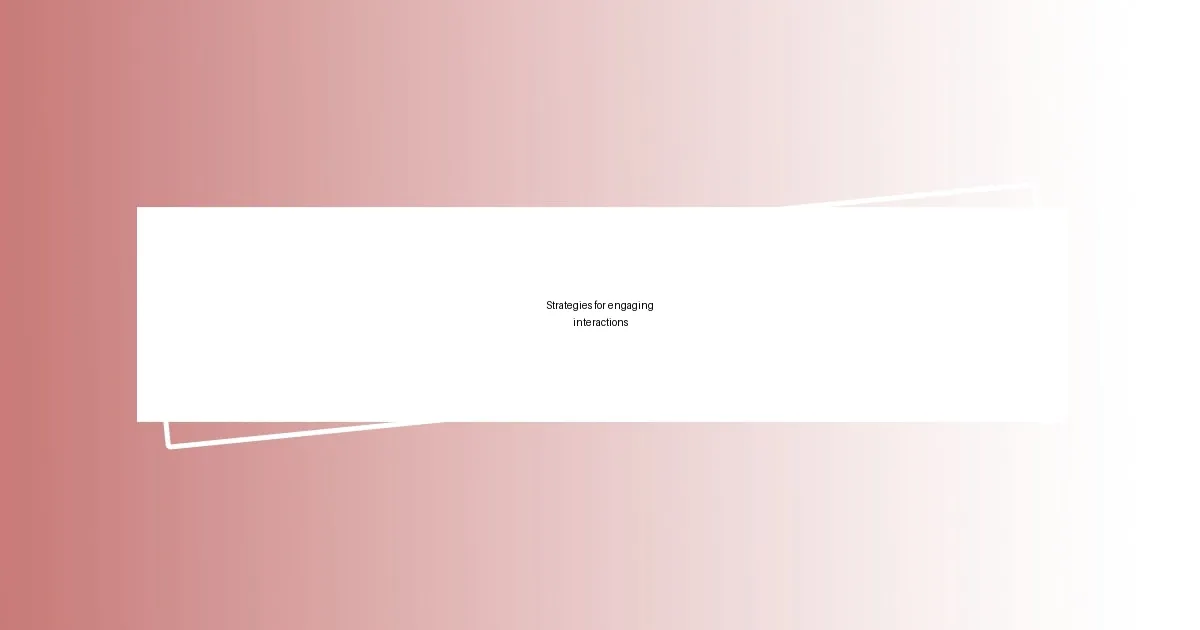
Strategies for engaging interactions
Building engaging interactions during events is all about fostering an environment of openness and connection. I vividly remember attending a networking event where the host encouraged icebreaker games. Those light-hearted activities transformed the room’s atmosphere, allowing attendees to relax and approach others naturally. It’s amazing how such simple strategies can break down initial barriers and encourage genuine conversations.
Another effective tactic I’ve found is the power of storytelling. During a recent panel discussion, one speaker shared a personal journey that resonated deeply with the audience. As I listened, I could see the shift in energy; people leaned in, eager to connect with the speaker’s experience. Stories create emotional engagement which can lead to more meaningful interactions. It makes me wonder: how often do we overlook the potential of our own stories in conversations? We all have unique experiences that can foster empathy and create memorable exchanges.
Lastly, utilizing technology can significantly enhance engagement. I remember an event where the organizers employed an app for live Q&A sessions. This tool allowed us to ask questions anonymously and vote on what to discuss next. The result was a lively discussion that kept everyone on their toes and engaged. It reinforced for me how technology, when used effectively, can enhance interaction and participation, making everyone feel included and valued.
| Strategy | Description |
|---|---|
| Icebreaker Games | Activities to promote relaxation and natural conversation. |
| Storytelling | Sharing personal experiences to create emotional connections. |
| Technology Tools | Using apps for live discussions to boost engagement. |
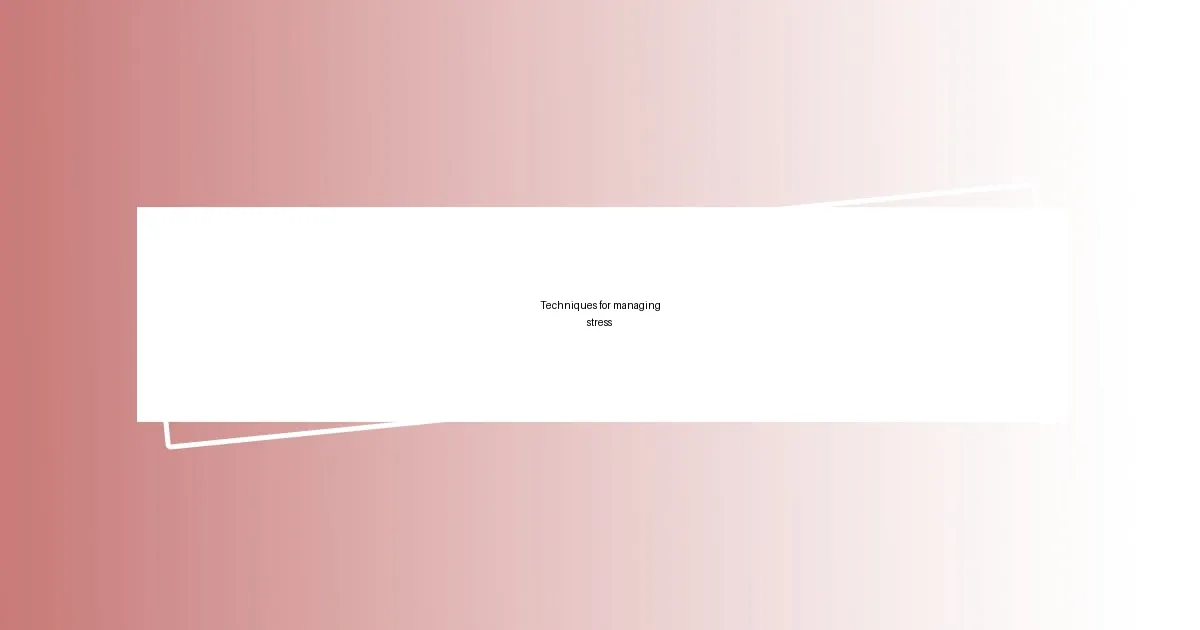
Techniques for managing stress
Stress can creep in during events, but I’ve found some techniques that really help me stay calm and focused. One approach that works wonders is the practice of deep breathing. I remember standing in a crowded conference hall, feeling overwhelmed, when I decided to step aside for a moment. Taking slow, deliberate breaths helped me regain my composure, reminding me that I control my response to the environment around me. Have you ever paused to breathe and felt the weight lift off your shoulders? It’s a simple yet effective tool that anyone can use.
Another technique I’ve incorporated into my routine is mindfulness. Before attending events, I take a few minutes to envision what I’ll encounter. This mental preparation eases the fear of unexpected surprises. I recall a time at a trade show when everything felt chaotic. Instead of spiraling into anxiety, I paused to visualize my interactions, which allowed me to engage more authentically with others. I genuinely believe that our mindset shapes our experience. So, how do you mentally prepare for social situations?
Lastly, creating an exit plan has been a lifesaver for me. Knowing I have the option to step out when the atmosphere becomes too intense brings a sense of control. During a networking function last month, I felt a wave of anxiety hit me. Just knowing I could take a quick break in the lobby reassured me enough to enjoy the event without feeling trapped. By planning my escape routes—figuratively and literally—I can navigate the event landscape with confidence. Don’t you find that having a strategy can often provide relief in tense situations?
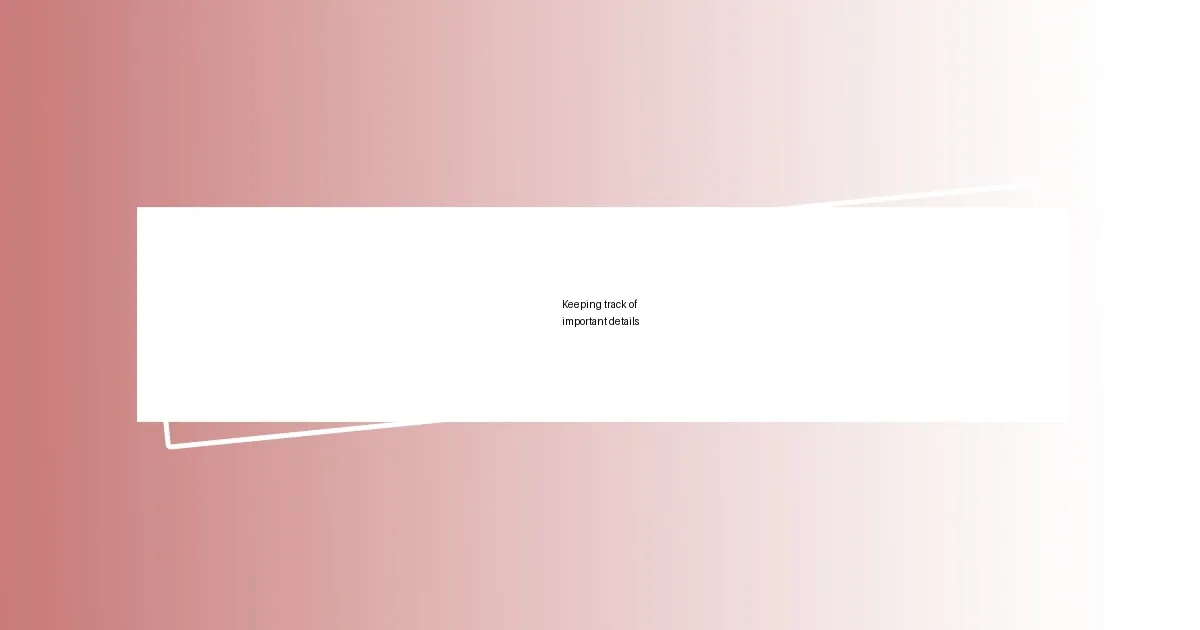
Keeping track of important details
Keeping track of important details during events has always been a challenge for me, but I’ve discovered some strategies that truly help. I often rely on my trusty notebook or note-taking app to jot down key points, interesting conversations, and contact information. Once, during a workshop, I felt like a sponge soaking in so much knowledge, but without taking notes, I would have forgotten valuable insights. Have you ever left an event with a mind buzzing but struggled to recall anything?
Moreover, I’ve learned the importance of following up promptly after an event. If I meet someone intriguing, I make sure to connect with them on LinkedIn or send a quick email within a day or two. There was a situation where I met a potential collaborator at a conference but didn’t reach out immediately. By the time I got around to it, the enthusiasm faded, and so did their interest. This experience taught me that timing is crucial; that initial excitement can slip away if not captured promptly.
Visualizing the event layout also keeps my bearings straight. I try to memorize where key sessions or vendors are located, which means I don’t waste time figuring out where to go next. I still recall standing at a trade show, overwhelmed by numerous booths and presentations. After jotting down a simple map in my notebook, navigating the space became so much easier. It turned out to be a game-changer that added so much more enjoyment to the experience. How do you navigate busy events without losing your way?
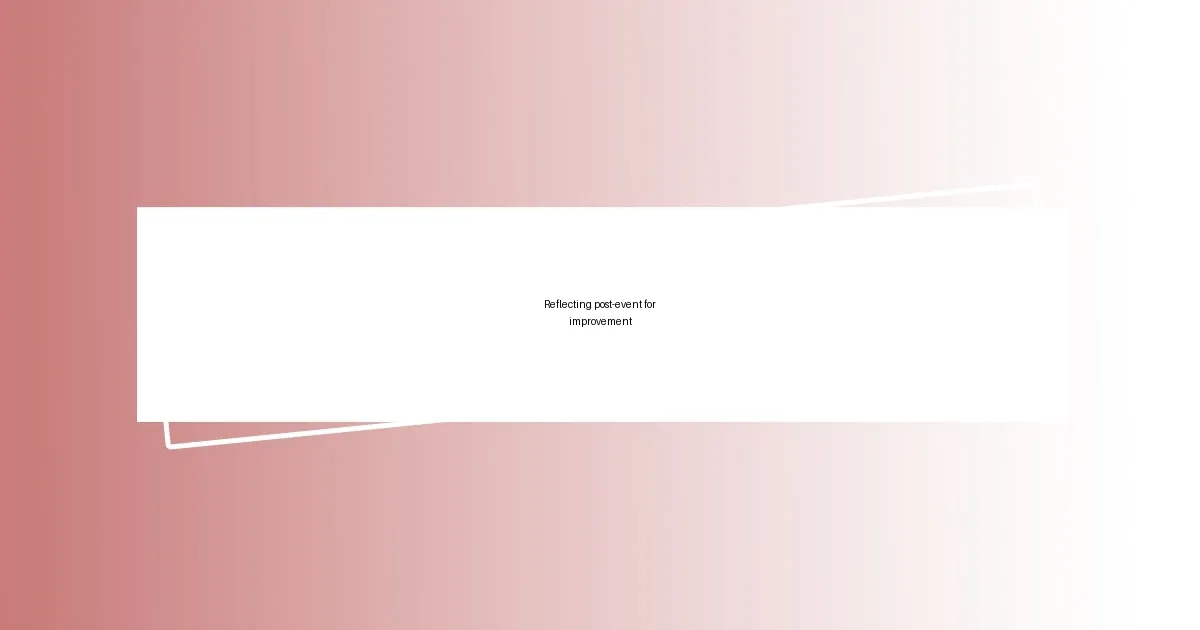
Reflecting post-event for improvement
Reflecting on an event afterward can feel like peeling back layers of an onion. I often find myself thinking about what went well and what didn’t. Once, after a particularly intense seminar, I realized that my tendency to hold back in discussions limited my networking opportunities. It made me wonder: how often do we prioritize our comfort over potential connections? I vowed to push myself more next time.
Writing down my thoughts right after the event helps clarify my feelings. I recall attending a bustling industry expo where I initially felt like just another face in the crowd. However, as I captured my experiences in a journal later that night, I recognized moments of genuine connection that I hadn’t appreciated at the time. This practice not only solidifies my learning but also evokes gratitude for the people I interacted with. Have you ever captured a thought that shifted your perspective after the noise settled?
Moreover, discussing the event with friends or colleagues can provide insightful feedback I might not have considered. I remember reflecting on an event with a close friend who attended a similar session. Their perspective unveiled challenges I hadn’t seen and helped me identify areas for growth. Sharing experiences creates a sense of community, which can transform isolated moments of self-reflection into collaborative learning. How do you turn your event experiences into a chance for collective improvement?














